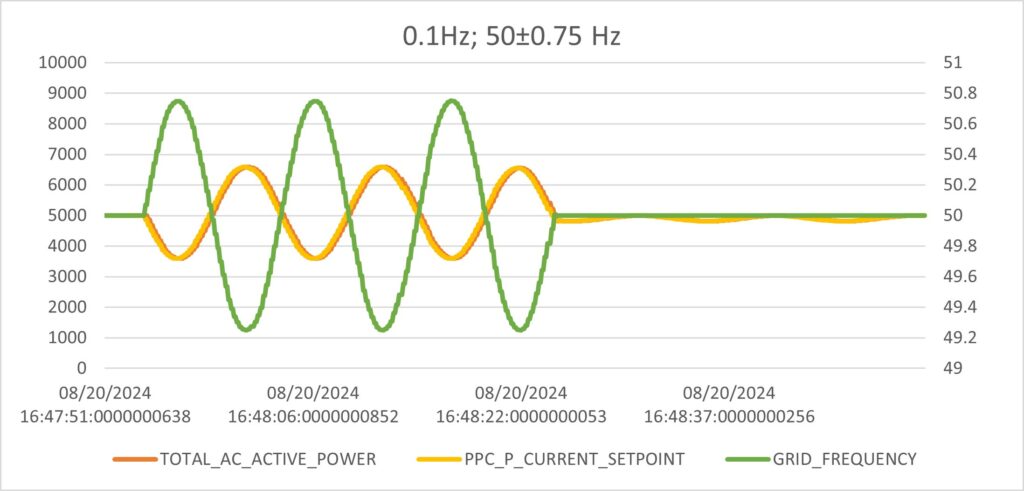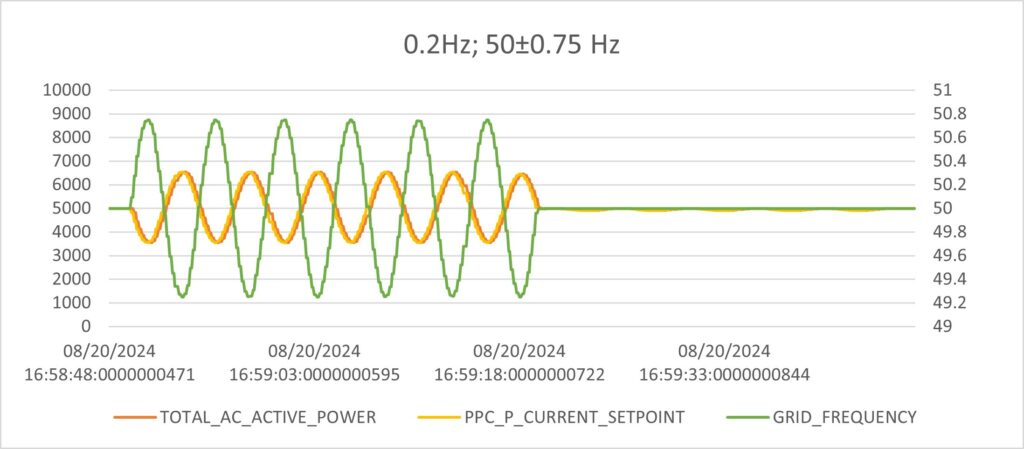Following significant development and simulation of the control, GPM has successfully tested the Power Oscillation Damping controller at an operational PV plant with Grid Operator Approval
With the rise of renewable energy sources like wind, solar, and storage, which introduce new dynamics to the grid, Power Oscillation Damping (POD) controllers have become increasingly important to ensure reliable and stable power delivery. In the past, large synchronous generators ensured grid stability due to their high inertia, effectively handling disturbances. Renewable inverter-based plants, while offering greater control and responsiveness, lack this robustness, needing careful coordination between these two systems to maintain grid reliability and reduce vulnerability to outages.
As grid codes evolve, wind and PV farms are now expected not only to supply power but also to support grid stability. Traditionally mitigated by stabilizers on turbine generators, countries like Mexico and Spain now require Power Plant Controllers (PPC) to offer this service.
When were Power Oscillation Damping control requirements first introduced?
Power Oscillation Damping control requirement first introduced by CENACE
The Power Oscillation Damping control requirement was first introduced by CENACE(The National Center for Energy Control) in Mexico as a simulation requirement for all their new PV Plants. At that time, GPM developed a controller which was able to dampen the oscillation within the required frequency range. Until recently, the validation of this control capability had been confined to simulation environments. However, in late 2024, GreenPowerMonitor, a DNV company (GPM) successfully tested the Power Oscillation Damping (POD) capability using a GPM Controller at an operational PV plant.
How does Power Oscillation Damping control work?
GPM Power Oscillation Damping Control (GPM POD)
GPM Power Oscillation Damping (GPM POD) reduces oscillation and makes power transfer more stable, while reducing additional costs and supporting grid operators to meet regulations that ensure our power networks are ready for the clean-energy transition.
Unlike traditional inverter POD control, GPM’s POD functionality uses the power plant’s centralized control to operate directly, removing the need for additional equipment.
GreenPowerMonitor, a DNV company developed the GPM POD2:
- A control technique designed to detect power system oscillations and send appropriate setpoints to inverters to counteract them
- It works by generating power setpoints in counterphase to the disturbance and can adjust either active or reactive power output
- This method effectively enhances the damping ratio of oscillations.
However, to help reduce the oscillations, the plant must be capable of reacting around 10 times faster than the period of the oscillation.GPM’s solution: the GPM POD control system can detect an oscillation in the measurements at the Point of Connection
In order to dampen the oscillatory disturbance, the plant must be capable of injecting power in counterphase to the disturbance thus reducing its impact. Therefore, to successfully do so, the plant must be capable of reacting fast enough to inject power at the adequate frequency.
Since PV plants are at times not capable of reacting at the required loop times, POD control is usually performed either at an inverter level or by means of a STATCOM. In the case of the POD system developed by GPM, the POD control is performed by the GPM Power Plant Controller (PPC) solution.
The GPM POD control system can detect an oscillation in the measurements at the Point of Connection (POC) within the frequency range between 0.2 and 3 Hz.
- Upon detecting the oscillation, the plant control modifies the power output of the PV plant, increasing the damping ratio of the oscillation
- Correct operation of this control mode requires very low loop times both from the PV inverters and the meters at the POC.
Should these requirements not be fulfilled, the POD control will not be successful and in some cases destabilize the system.
How has the GPM Power Oscillation Damping Control (GPM POD) been tested?
At the PV plant in Lithuania, tests have been performed by introducing a sine wave oscillation on the frequency measurements that GPM’s PPC reads. This type of emulated signal testing allows us to test the performance of the real system to a power system oscillation.
The emulated sine wave test naturally does not show any damping by itself because the emulated disturbance is not of an electrical origin. However, the ability that the POD Control has to act in counterphase to the disturbance is visibly demonstrated.
The tests have been performed at different PPC Loop times and with varying disturbance frequencies, showing the relationship between the GPM PPC Loop time and the ability to detect and act upon a power oscillation.
Luis Serrano, Unit Director of Onsite Solutions EMEA&LATAM, GreenPowerMonitor, a DNV company, says of the project: “We are delighted to have successfully tested our solution at an operational PV plant and are excited to implement our POD in more projects across the globe. Infrastructure for grid reliability is key to the energy transition, and our POD is able to support a greener energy mix in grids across the regions.”
What are the GPM POD testing results in this case?
Dissemination of the real plant data is confidential in this case. Therefore, for the demonstration of the system’s performance here, results of the actual GPM PPC connected to a Hardware in the Loop simulation of a plant has been used.
- The results demonstrate a counter-phase response in the active power, effectively damping the frequency oscillation.
- This action plays an important role in helping the system maintain stability during such phenomena, ensuring reliable operation when similar disturbances occur in the electrical grid.


Conclusion: The GPM POD receives TSO approval for its operation
In conclusion, the GPM POD control is capable of improving the damping of inter-area disturbances based on the general POD grid code requirements. In addition, the plant must be capable of set-point tracking at least 10 times faster than the disturbance frequency. Otherwise, the POD control mode could potentially in some cases destabilize the system. Therefore, correct operation of this mode is greatly conditioned by the GPM PPC loop time setting, the inverter’s loop time and the speed at which the meters refresh the measurements at the POC.
This control technique has been used along with the emulated frequency method to run grid compliance testing at an operational PV plant and successfully received TSO approval for its operation. Subsequent testing in other sites will most likely follow the same methodology as it allows for the system to demonstrate its control capability without introducing real disturbances in the grid frequency and voltage.
More information about GPM PPC’s power oscillation damping capability is also available in the technical whitepaper, The future of grid stability: Advancements in power oscillation damping. The full paper is available to download here.
Do you want to meet us and talk to our renewable energy experts?
For more information on GPM’s work and solutions, including GPM PPC and GPM POD control, fill in the form to request a meeting with our renewable energy experts who will be available to answer questions, provide demonstrations, and offer insights on best practices.

